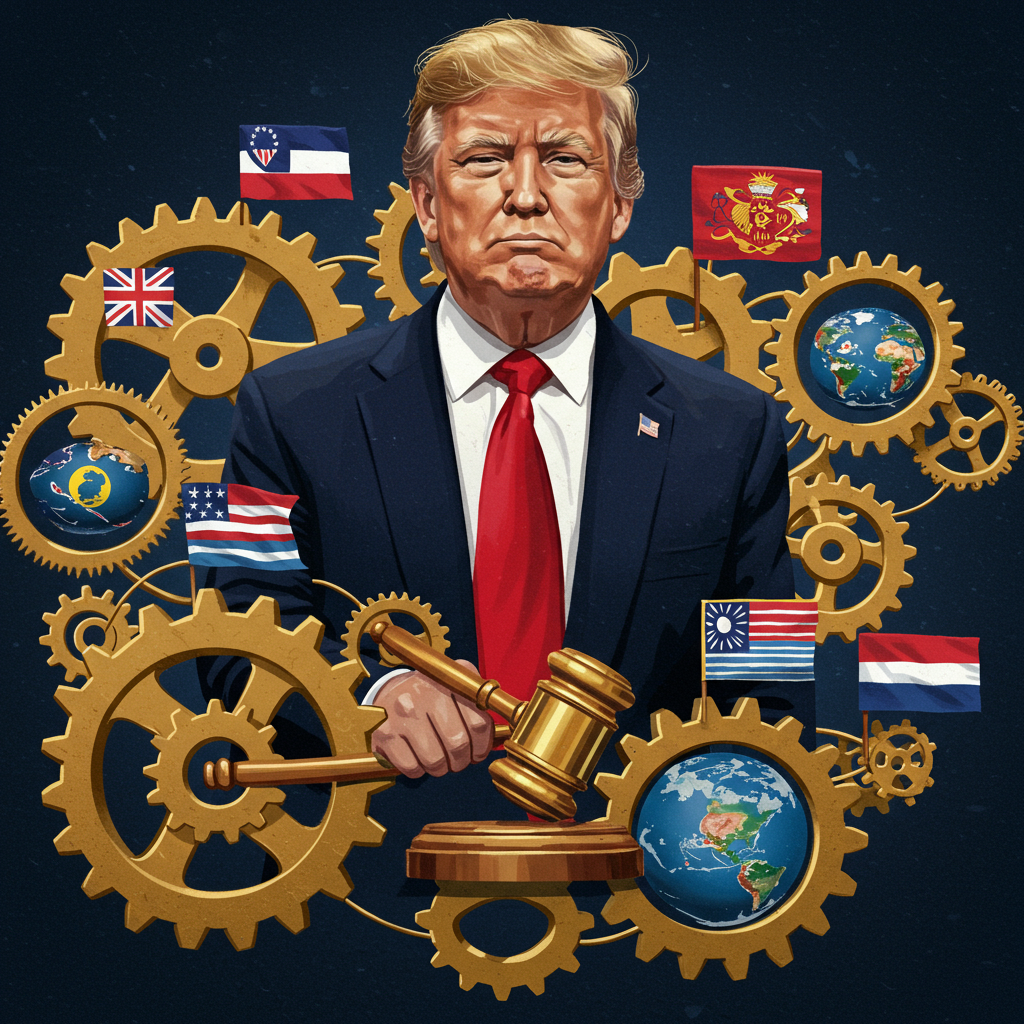Global trading partners faced a critical deadline as the Trump administration signaled its intent to impose significantly higher tariffs on imports. Unless new bilateral trade agreements were finalized, these elevated duties were set to take effect starting August 1. This move marked the potential end of a temporary pause period designed for intense negotiations.
Trump’s “Maximum Pressure” Tariff Strategy
The push for new tariffs is part of President Trump’s broader trade strategy. Treasury Secretary Scott Bessent characterized this approach as applying “maximum pressure.” The administration’s goal was to secure trade deals it deemed more favorable to the United States. Bessent defended this stance, stating it was diplomacy, not a threat. He explained that countries had a choice: speed up negotiations to reach a deal or face a return to higher tariff rates. This pressure, he suggested, was proving effective, even with major blocs like the European Union.
The July 9 Negotiation Deadline vs. August 1 Implementation Date
It’s crucial to understand the distinction between two key dates. The July 9 date represented the self-imposed deadline for countries to negotiate and finalize trade agreements with the US. This date marked the end of the 90-day reprieve period that began around April 9, during which only a baseline 10% tariff generally applied. August 1 was the date the higher, specified tariffs would actually be implemented if no deal was struck by July 9. Bessent clarified that August 1 was not a new negotiation window but rather the date the “previously suspended levies” would “boomerang back” to their higher levels if agreements remained elusive.
Notification Letters and Tariff Rate Range
As the July 9 deadline approached, President Trump announced his administration would begin sending letters to trading partners. These letters were intended to formally notify nations of the specific tariff rates their exports would face if a deal wasn’t secured. The first batch included about 10 to 12 letters, with subsequent notifications planned to cover all partners by the deadline. The potential tariff rates outlined in these letters varied dramatically, ranging from around 10% or 20% to significantly steeper duties as high as 60% or even 70%. This wide range underscores the individualized nature of the proposed “reciprocal” terms the US sought. Treasury Secretary Bessent anticipated that approximately 100 trading partners could face a minimum reciprocal rate of 10% if deals weren’t reached in time.
Stalled Talks and Varied Responses
While the US expressed optimism about reaching multiple agreements, negotiations with key partners proved challenging. Many countries, particularly large economies, found it difficult to finalize comprehensive deals within the tight 90-day timeframe. European Commission President Ursula von der Leyen stated that achieving a detailed agreement covering substantial trade volumes within 90 days was “impossible,” aiming instead for agreements “in principle.” Only a few countries globally had managed to conclude such agreements. India’s trade minister emphasized that any free trade agreement needed to be a “win-win” for both sides.
Negotiations with Key Global Players
The US administration focused its negotiation efforts on approximately 18 key trading partners. These nations collectively accounted for a significant portion (95%) of the US trade deficit. Despite the stated urgency, Bessent noted “a lot of foot-dragging” by countries in finalizing texts, although he also expressed anticipation for a “flurry” of deals.
European Union
The EU, representing a substantial share of global trade, faced potential tariffs as high as 50% on goods entering the US if no agreement was reached. The bloc signaled willingness to accept a universal 10% tariff on many exports. However, they were actively seeking exemptions for sensitive sectors crucial to their economies, including pharmaceuticals, alcohol, semiconductors, and commercial aircraft, as part of any potential trade deal. Talks between EU and US negotiators continued intensely, even through weekends preceding the deadline. The US had also reportedly threatened a separate 17% tariff specifically on EU agricultural exports.
Japan
Negotiations with Japan reportedly encountered significant difficulties. President Trump publicly stated his intention to compel Japan to accept higher tariffs. He suggested potential rates of “30%, 35%, or whatever the number is,” noting these were higher than the previous 24% “Liberation Day” proposal. Trump described Japanese negotiators as “very tough” and “very spoiled,” indicating a difficult negotiation dynamic. Japan’s Prime Minister Shigeru Ishiba affirmed that Tokyo would “won’t easily compromise” in its trade discussions with the US.
South Korea
South Korea actively sought an extension to the strict July 9 deadline. Their Trade Minister engaged in direct talks with the US Trade Representative. South Korea proposed manufacturing partnerships and requested the elimination or reduction of US tariffs on key products essential to their export market, such as automobiles and steel.
China
Despite ongoing trade tensions, there were signs of a slight easing of relations in certain areas, contrasting with the broader tariff push. Following a framework agreement in May aimed at a larger trade deal, the US eased export restrictions on specific items for China. This included allowing companies like Synopsys and Cadence to resume selling chip design software and permitting ethane exports. However, the US also planned separate measures to restrict AI chip shipments to Malaysia and Thailand, citing concerns about potential smuggling into China, highlighting the complex and multi-faceted nature of US trade policy towards the region. Separately, China announced countermeasures against the EU amidst their own trade disputes, banning European medical device companies from selling to the Chinese government above a certain budget threshold and imposing anti-dumping duties (ranging 27.7% to 34.9%) on European brandy (specifically French cognac) for five years.
Vietnam
President Trump announced that a trade deal had been successfully reached with Vietnam. Under the terms he described, Vietnamese imports into the US would face a 20% tariff. While still a significant duty, this was lower than the 46% rate that had been previously threatened. A higher 40% tariff would apply to goods deemed to be “transshipping” through Vietnam but originating from another country, likely targeting products attempting to circumvent tariffs from nations like China. Many US goods, conversely, were expected to enter Vietnam duty-free under the proposed agreement. However, Vietnamese negotiators indicated that they were still working with the US to finalize the detailed terms of the deal, leaving some specifics uncertain for businesses and investors.
Canada
Canada made a notable move ahead of the deadline by repealing its digital services tax. This tax had specifically targeted large US technology companies and had been a point of contention. Following a previous threat from President Trump to halt discussions, trade talks between the US and Canada resumed. Both nations aimed to reach a trade agreement by mid-July.
Other Nations’ Efforts
Other countries also actively engaged in efforts to secure deals and avoid the looming higher tariffs. Thailand, for example, was reportedly working to refine its trade proposal framework in a race against the July 9 deadline. Indonesia made significant concessions during its tariff talks, offering to cut duties on key US imports to “near zero” and committing to a substantial purchase of $500 million worth of US wheat in an attempt to gain a favorable agreement.
Market Uncertainty and Broader Impacts
The impending deadline and the prospect of widespread tariff increases created significant uncertainty for global investors. This period marked the end of a roughly 90-day phase characterized by relative volatility and negotiation pauses, potentially ushering in a new era of heightened trade tensions. Data from shipping companies like Maersk had previously indicated average US container import tariffs were around 21% and trending downwards, a situation that the new, potentially much higher rates could drastically alter. The tariffs also had potential impacts on specific sectors, including US shale drilling executives, and disrupted air shipments of low-value goods from China due to the end of a previous tax-free loophole. Global leaders from the BRICS nations, meeting in Rio de Janeiro, were also expected to voice strong opposition to the US tariff strategy, viewing the measures as “illegal” and potentially harmful to the global economy.
Frequently Asked Questions
What were the critical deadlines associated with the Trump tariffs?
There were two key dates. July 9 was the self-imposed deadline for trading partners to finalize new bilateral trade deals with the United States. August 1 was the date when the specified higher tariff rates would automatically take effect on imports from countries that had not successfully negotiated and finalized a trade agreement by the earlier July 9 deadline.
Which countries were primarily impacted by the potential new US tariffs?
The US administration focused negotiations on about 18 key trading partners, accounting for 95% of the trade deficit. Major countries and blocs facing potential tariffs included the European Union, Japan, South Korea, China, Canada, Vietnam, Thailand, and Indonesia. The tariffs would apply unless these nations secured specific bilateral deals by the negotiation deadline.
What range of tariff rates did President Trump indicate were possible?
President Trump stated that the potential new tariff rates outlined in the notification letters would vary widely depending on the country and product. The rates could range from as low as 10% or 20% up to potentially 60% or 70%. Treasury Secretary Bessent mentioned a minimum reciprocal rate of 10% was likely for around 100 trading partners without deals.
Conclusion
The final days leading up to the July 9 negotiation deadline were a period of intense activity and uncertainty in global trade. With the threat of significantly higher tariffs looming large, set to activate on August 1 for countries without finalized deals, nations scrambled to negotiate or position themselves. The Trump administration’s “maximum pressure” strategy, employing direct notification of potential steep duties, underscored a firm stance on achieving reciprocal trade terms. While some deals were announced or neared completion, others faced significant hurdles and resistance, leaving the global trade landscape volatile and unpredictable as the deadlines approached.
Word Count Check: 1087


